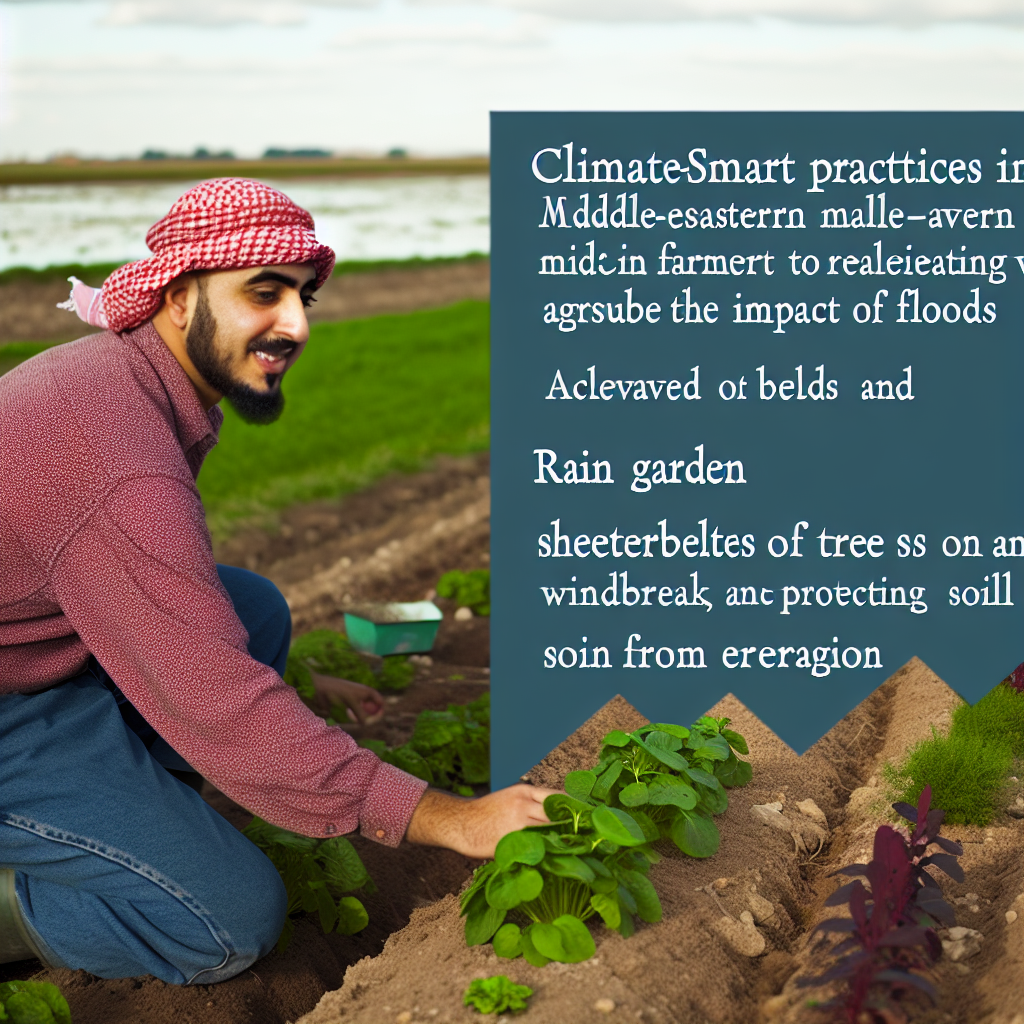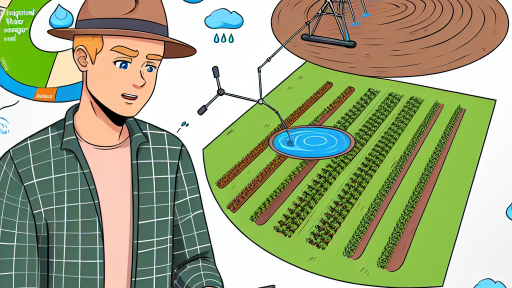Introduction to Flood Impact on Agriculture
Flooding significantly affects agricultural productivity worldwide.
The immediate effects of floods include soil erosion and nutrient loss.
Field saturation leads to reduced crop yields and poor harvest quality.
Consequently, farmers face financial losses and increased recovery costs.
Long-term impacts involve changes in land use and crop selection.
In some regions, farmers may need to abandon their lands entirely.
Floods also disrupt planting schedules, further complicating agricultural planning.
In addition to crops, livestock also suffers during severe flooding events.
Farmers must address both immediate and lingering effects of these disasters.
Many farmers lack sufficient resources for effective recovery after flooding.
Understanding the impact of floods allows for better preparedness and adaptation.
Therefore, climate-smart practices are essential for reducing these impacts.
Understanding Climate-Smart Practices
Definition and Purpose
Climate-smart practices aim to enhance resilience against climate change.
They focus on improving agricultural productivity sustainably.
These practices also help mitigate greenhouse gas emissions.
Transform Your Agribusiness
Unlock your farm's potential with expert advice tailored to your needs. Get actionable steps that drive real results.
Get StartedUltimately, they address the dual challenge of food security and climate change.
Key Principles
Several principles guide climate-smart agriculture.
First, enhancing productivity sustainably is crucial.
This principle aims to increase yields without harming the environment.
Second, farmers should adapt to changing climate conditions.
This adaptation often includes selecting resilient crop varieties.
Lastly, reducing greenhouse gas emissions remains a priority.
Farmers can achieve this by implementing efficient resource management.
Impact on Flood Management
Climate-smart practices significantly help reduce flood risks.
They improve soil health, allowing for better water absorption.
Healthy soils can mitigate runoff and reduce erosion.
Moreover, crop rotation and cover cropping enhance soil structure.
These techniques decrease vulnerability to flood damage.
Adoption Strategies
Farmers can adopt climate-smart practices through various strategies.
Training programs can enhance farmer knowledge and skills.
Furthermore, providing financial incentives can encourage adoption.
Local organizations play a crucial role in supporting farmers.
Partnerships between governments and NGOs often yield effective results.
Examples of Climate-Smart Practices
Several examples illustrate effective climate-smart practices.
- Agroforestry integrates trees and shrubs into crop systems.
- Conservation tillage minimizes soil disruption and enhances moisture retention.
- Using native plants can increase biodiversity and improve landscape resilience.
- Water management techniques optimize irrigation and maintain soil health.
These practices not only enhance productivity but also protect against flooding.
Soil Management Techniques to Enhance Water Retention
Importance of Soil Health
Healthy soil plays a crucial role in water management.
It improves water infiltration and retention in agricultural fields.
Moreover, healthy soil supports plant health and productivity.
Organic Matter Addition
Incorporating organic matter is vital for enhancing soil structure.
Showcase Your Farming Business
Publish your professional farming services profile on our blog for a one-time fee of $200 and reach a dedicated audience of farmers and agribusiness owners.
Publish Your ProfileCompost and manure improve moisture retention significantly.
Furthermore, these materials provide essential nutrients for crops.
Cover Cropping
Cover crops prevent soil erosion during heavy rainfall.
They also enhance soil organic matter when tilled back into the soil.
Additionally, cover crops reduce water runoff and increase infiltration.
Contour Farming
Contour farming involves plowing along the contours of the land.
This practice reduces soil erosion and manages water flow effectively.
Moreover, it helps retain moisture levels in the soil.
Mulching Techniques
Applying mulch retains soil moisture and suppresses weeds.
Organic mulches, such as straw or wood chips, are highly effective.
They further enhance soil fertility as they decompose.
Water Management Systems
Implementing drainage systems helps prevent waterlogging in fields.
Farmers can also use rainwater harvesting techniques.
This practice provides an additional water source during dry spells.
Reducing Soil Compaction
Soil compaction inhibits water infiltration and root growth.
Using cover crops or reducing heavy machinery use can combat compaction.
As a result, this practice promotes healthier soil and improved water retention.
See Related Content: Soil Management Tips for Effective Carbon Sequestration
Crop Selection and Diversification for Flood Resilience
The Importance of Crop Selection
Choosing the right crops is crucial for flood-prone areas.
Flood-resistant crops can withstand waterlogged conditions better.
Examples of such crops include rice and certain varieties of sorghum.
These crops have developed traits that allow them to thrive in wet soils.
Additionally, farmers can explore local plant varieties that are naturally resilient.
Diversification Strategies
Diversification minimizes risks associated with crop failure.
Planting multiple crops spreads out the risk of loss due to flooding.
For example, combining legumes with cereals enhances soil health and resilience.
Moreover, intercropping can help manage water levels effectively.
This method allows farmers to maximize their land use while improving yields.
Implementing Crop Rotation
Crop rotation encourages variety and prevents depletion of soil nutrients.
It also disrupts pest and disease cycles, promoting healthier crops.
In addition, rotating flood-resistant crops with other types can break up potential risk.
This practice allows for better soil management in flood-prone regions.
Research and Resources
Farmers should stay informed about new crop varieties and agricultural practices.
Many agricultural extension services offer guidance on flood resilience strategies.
Additionally, farmers can collaborate with local research institutions.
Such partnerships can provide valuable knowledge on effective crop selection.
Community Support and Collaboration
Building a strong local community enhances resilience to flooding.
Sharing experiences and strategies among farmers fosters innovation.
Furthermore, participating in cooperative initiatives can enhance resource sharing.
This approach enables farmers to learn from each other’s successes and challenges.
Showcase Your Farming Business
Publish your professional farming services profile on our blog for a one-time fee of $200 and reach a dedicated audience of farmers and agribusiness owners.
Publish Your ProfileSee Related Content: Resilient Farming Strategies for Climate Change Impact
Implementing Agroforestry Systems to Reduce Runoff
Introduction to Agroforestry
Agroforestry integrates trees and shrubs into farming systems.
This practice enhances biodiversity and ecosystem health.
It provides multiple benefits for soil and water management.
Benefits of Agroforestry in Flood-Prone Areas
Agroforestry reduces surface runoff, enhancing water absorption.
The tree roots stabilize soil, preventing erosion.
Additionally, it captures and stores rainfall effectively.
The presence of trees improves soil structure and fertility.
Types of Agroforestry Systems
Several agroforestry systems can aid in flood prevention.
- Alley cropping involves planting crops between rows of trees.
- Silvopasture integrates trees, livestock, and forage crops.
- Forest farming allows various crops to grow under tree canopies.
Each system offers unique advantages based on the specific environment.
Implementation Strategies
Begin by assessing the land’s characteristics and flood risks.
Select tree species that thrive in local conditions.
Develop a clear plan for planting and maintenance.
Involve local farmers in the decision-making process.
Monitoring and Evaluation
Regular monitoring ensures the agroforestry system is effective.
Track soil health, crop yields, and water retention over time.
Adjust management practices based on observed outcomes.
Through evaluation, farmers can optimize their systems for maximum benefits.
You Might Also Like: Precision Agriculture for Effective Emission Control
Water Management Strategies
Rainwater Harvesting
Rainwater harvesting efficiently collects and stores rainfall for agricultural use.
This practice reduces dependency on groundwater and surface water sources.
Farmers can install collection systems to capture rainwater from roofs and surfaces.
The stored water can irrigate crops during dry spells.
Moreover, it reduces runoff and helps prevent soil erosion.
Benefits of Rainwater Harvesting
- Improves water availability in arid conditions.
- Reduces pressure on local water supplies.
- Enhances soil moisture levels.
Implementing this system leads to greater resilience against droughts.
Additionally, it promotes the sustainable use of water resources.
Irrigation Efficiency
Efficient irrigation methods minimize water waste on farms.
Farmers can adopt techniques like drip irrigation and sprinkler systems.
Such methods deliver precise amounts of water directly to plant roots.
This approach optimizes water usage and boosts crop yields.
Modern Technologies in Irrigation
- Soil moisture sensors help determine the right time to irrigate.
- Automated systems can schedule watering based on weather conditions.
- Data analysis tools provide insights into water application efficiency.
Utilizing technology enhances irrigation management significantly.
Consequently, farmers can improve productivity while conserving water.
Uncover the Details: How No-Till Farming Contributes to Carbon Sequestration

Use of Cover Crops to Protect Soil and Increase Biodiversity
The Role of Cover Crops
Cover crops play a crucial role in sustainable farming.
They protect and enrich the soil when main crops are not growing.
By covering bare soil, they help prevent erosion.
This practice also enhances soil structure and health.
Moreover, cover crops contribute organic matter to the soil.
Types of Cover Crops
Various types of cover crops exist to suit different farming needs.
Leguminous cover crops, like clover and vetch, fix nitrogen in the soil.
Showcase Your Farming Business
Publish your professional farming services profile on our blog for a one-time fee of $200 and reach a dedicated audience of farmers and agribusiness owners.
Publish Your ProfileGrasses, such as rye and oats, improve soil structure and prevent compaction.
In addition, brassicas like radishes can break up dense soil layers.
Farmers can select cover crops based on specific soil health goals.
Benefits of Using Cover Crops
Using cover crops offers numerous benefits to farmers.
They reduce nutrient runoff, which protects nearby water bodies.
This practice aids in controlling weeds by suppressing their growth.
Furthermore, cover crops can enhance soil moisture retention.
This feature is particularly important during dry seasons.
Enhancing Biodiversity
Cover crops support increased biodiversity on farms.
They create habitats for beneficial insects and wildlife.
Additionally, diverse plant life attracts various pollinators.
This helps improve crop yields and resilience.
Implementing cover crops leads to healthier ecosystems overall.
Challenges and Considerations
Despite their advantages, some challenges exist with cover crops.
Farmers must consider potential competition for nutrients with main crops.
Timing of planting and terminating cover crops is vital for success.
Additionally, proper management and input may be required.
Farmers are encouraged to assess their unique farm conditions first.
Creating Flood Buffer Zones
Importance of Flood Buffer Zones
Flood buffer zones play a crucial role in protecting farmland.
These zones help absorb excess water during flood events.
Moreover, they reduce soil erosion and nutrient loss.
Establishing these areas enhances farm resilience to climate change.
Natural Barriers for Flood Protection
Natural barriers serve as effective flood buffer zones.
Plants and trees can slow down water flow significantly.
For instance, wetlands store excess rainwater efficiently.
Additionally, well-placed barriers can redirect floodwaters away from farmland.
Implementing Effective Barrier Strategies
Farmers can implement various strategies to create these barriers.
- Utilizing native vegetation strengthens the ecosystem.
- Creating contour strips can reduce surface runoff.
- Constructing berms adds an extra layer of protection.
Moreover, regular maintenance ensures these barriers are effective.
Community Involvement and Education
Engaging the community fosters collaboration on flood management.
Workshops can educate farmers about buffer zone creation.
Sharing success stories encourages wider implementation of these practices.
Furthermore, collaboration can lead to enhanced funding opportunities.
Case Studies of Successful Climate-Smart Farms
Farm Resilience in Louisiana
Louisiana’s Crescent Valley Farm adopted elevated planting techniques.
This method minimizes damage from flooding during heavy rainfall.
They implemented contour farming to control water runoff effectively.
As a result, their soil health improved significantly over the years.
Moreover, they diversified crops to better withstand climate variations.
This farm now serves as a model for flood-prone regions.
Innovative Practices in California
In northern California, Green Acres Farm utilizes rainwater harvesting.
This practice captures and stores excess rain during wet seasons.
Showcase Your Farming Business
Publish your professional farming services profile on our blog for a one-time fee of $200 and reach a dedicated audience of farmers and agribusiness owners.
Publish Your ProfileThe stored water nourishes crops during dry spells and droughts.
Additionally, they use cover crops to enhance soil structure.
This approach reduced soil erosion and improved nutrient retention.
Green Acres Farm demonstrates how innovation fosters resilience.
Outcomes from Vermont’s Sustainable Agriculture
Vermont’s Maple Grove Farm focuses on integrating agroforestry techniques.
This method creates natural buffers against floodwaters.
The trees absorb excess rain, slowly releasing it into the soil.
This practice has significantly reduced the farm’s flood risks.
Furthermore, it enhances habitats for wildlife in the area.
Maple Grove Farm showcases the strength of biodiversity in agriculture.
Community Impact in Texas
In Texas, Harmony Fields collaborates with local farmers to share resources.
The group promotes soil conservation practices collectively.
Farmers rotate crops and use organic fertilizers, enhancing soil health.
Flooding impacts have decreased significantly within their community.
This cooperative model fosters a strong, supportive farming network.
It proves that community collaboration strengthens resilience against climate challenges.
Additional Resources
NRCS Climate-Smart Mitigation Activities | Natural Resources …




